Are you ready to take your aquarium hobby to the next level? If you’re tired of the ordinary and seeking something extraordinary, why not explore the fascinating world of brackish water aquariums? In this comprehensive guide, we explore the top 18 fish species that thrive in brackish environments, ranging from the small and colorful to the large and mesmerizing.
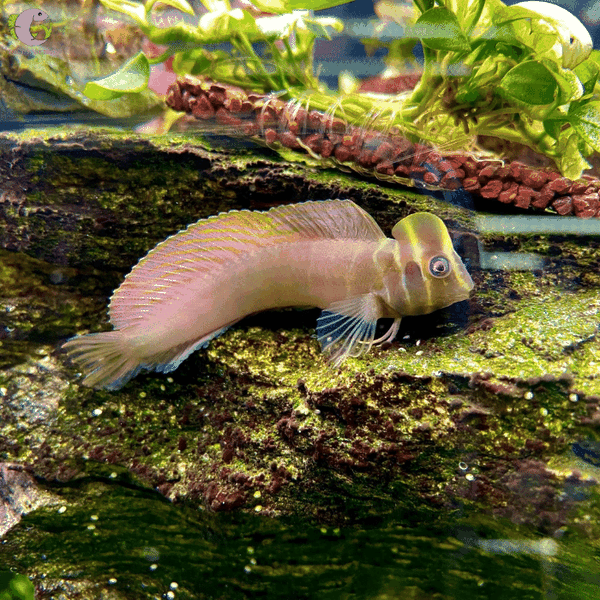
So you finally got tired of your freshwater fish tank and now want to try something extraordinary. Perhaps, my research and experience with brackish water aquarium fish may give you some cool stocking ideas.
Some of the species in my list will be small in size and others will be full-blown monsters.
I also tried to favor critters that are colorful and entertaining to look at.
Anyway, let’s find out what are the 18 best fish that can live in an aquarium with brackish water.
18 Brackish Water Aquarium Fish – Stocking Ideas
Usually, the salinity levels of brackish water are measured in what’s known as specific gravity and range between 1.000 and 1.019.
For this reason, during my research for this article, I made sure to select fish that can live in different parts of the brackish spectrum. This way you’ll have more flexibility with your stocking ideas.
Moreover, I also tried to diversify my picks between small and large species, with the latter usually requiring more advanced care.
You should be able to find pet fish that suit you regardless of your experience in the hobby or the size of your tank.
That being said, take a look at the brackish water fish that could go in your new aquarium:
1. Dwarf Indian Mudskipper – Periophthalmus novemradiatus
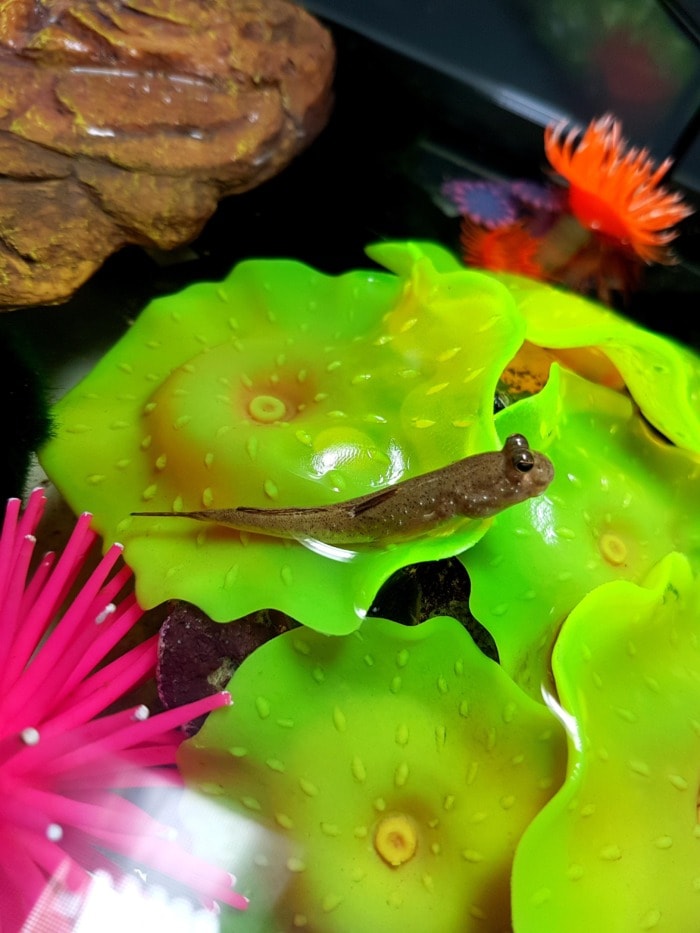
| Preferred Water Salinity: | 1.001 to 1.015, but does best at 1.005 |
| Key Traits: | requires access to land in its tank; needs high humidity; semi-aggressive; remains small; an oddball; hardy |
| Maximum Size: | 2.6 inches ( 6.6 cm) |
| Recommended Tank Size: | 20 gallon Long |
| Suitable for Beginners: | Yes, it’s an easy fish to keep as long as you put the effort of setting up the right tank conditions from the start |
The Dwarf Indian Mudskipper is a brackish water goby fish that feels best in the low-end of the salinity spectrum. This tropical fish species is also amphibious which means that it needs access to both land and water in its tank.
Anyway, since the Dwarf Indian Mudskipper grows to no more than 2.6 inches in size, it is a great candidate for a small brackish aquarium.
The Dwarf Indian Mudskipper is part of a genus named Periophthalmus, native to the Indo-Pacific region, mainly to coastal mangrove wood and shrubland.
My recommendation for a mudskipper tank setup would be a 20-gallon Long tank, that’s filled with about 10 gallons of water. The 20 gallon Long tank has a decent bottom footprint of 30.25 x 12.5 inches.
These dimensions will provide a group of 3 Indian Mudskippers fish with enough territory to feel comfortable among each other.
The tank should have a tight lid and the air inside should be warm and humid.
Anyhow, when it comes to behavior, the mudskippers can be one of the most entertaining aquarium pets you could keep.
They are highly intelligent and each specimen will be full of unique personality.
If you want to try a larger but more aggressive cousin of the Indian Mudskipper you can check out the African Mudskipper:

2. Oyster Toadfish – Opsanus tau

| Preferred Water Salinity: | between 1.010 and 1.015 |
| Key Traits: | exceptionally hardy; easy to keep; peaceful; is an ambush predator; less active during the day |
| Maximum Size: | normally around 12 inches ( 30.5 cm) but 15 inches (38 cm) are not impossible |
| Recommended Tank Size: | 60 gallons for adult fish |
| Suitable for Beginners: | Yes |
The Oyster Toadfish, also known as Oyster Cracker, is an euryhaline fish which means that it can tolerate a wide range of water salinity.
This brackish fish feels best in a range of 1.010 to 1.015 specific gravity, but there are also reports of it surviving for years in reef aquariums. In the wild, the Oyster Toadfish has been found in both low-end brackish and marine bodies of water.
The Oyster Toadfish is from a small genus known as Opsanus.
Anyway, this oddball fish is an ambush predator that inhabits caves near the sandy bottom.
Its feeding strategy is to patiently wait until an unsuspecting victim comes near the Toadfish’s mouth.
Author’s note: To keep an Oyster Toadfish in your brackish water aquarium you need to make sure that there’s at least one cave-like hideout for the fish to inhabit. A PVC pipe is usually a good choice, but do keep in mind that these fish are fast growers.
Anyhow, though some people classify the Oyster Toadfish as ugly I think it’s one of the coolest-looking fish that you could keep at home. Since this species has been studied thoroughly it is also known that it’s exceptionally hardy.
An Oyster Toadfish will tolerate very polluted water, irregular feeding opportunities, and living outside of brackish water for extended periods of time.
Obviously, this does not mean you should neglect yours.
3. Figure 8 Puffer – Tetraodon biocellatus
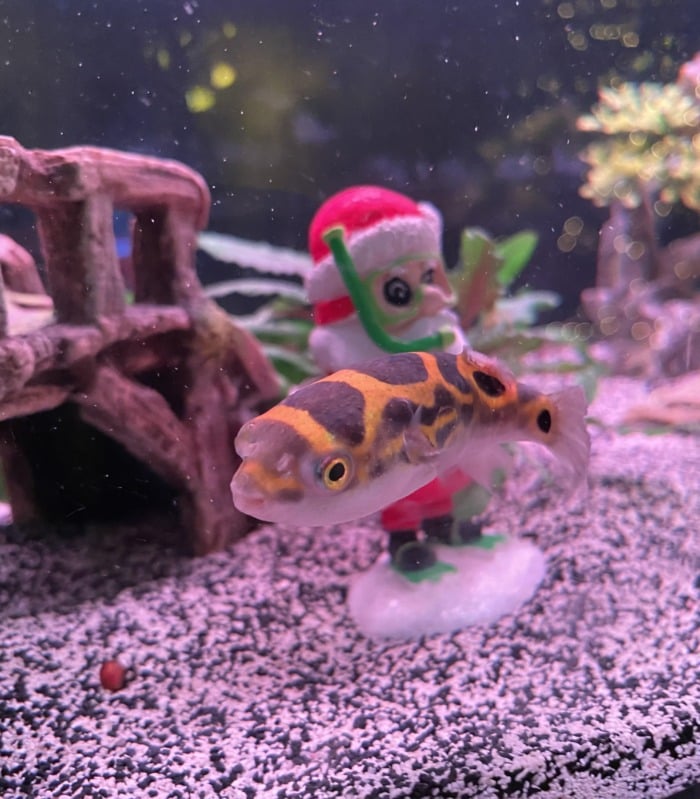
| Preferred Water Salinity: | 1.003 to 1.008 |
| Key Traits: | Big personality; curious explorer; intelligent; semi-aggressive; strictly carnivorous |
| Maximum Size: | 3 inches (7.62 cm) |
| Recommended Tank Size: | 15 gallons |
| Suitable for Beginners: | Yes |
The Figure 8 Puffer is a small and intelligent fish that grows to no more than 3 inches on average. It prefers a water salinity of between 1.003 and 1.008, which makes it one of the best candidates for a small aquarium with brackish water.
The Figure 8 Puffer is a strict carnivore and its diet in captivity should consist of live or freeze-dried foods.
They are members of the Tetraodon genus.
You can feed your puffer clams, crayfish, snail, krill, and shrimp.
These puffer fish have beaks that allow them to break the shells of tiny crustaceans and mollusks. In fact, pufferfish species are known to eat aquatic pest snails.
Related Read: Small Aquatic Snails (That Can Become a Pest in Your Tank)
Author’s note: A very important thing to remember when looking after a Figure 8 Puffer is that its beak can overgrow, making it more and more difficult for the fish to feed. To keep its beak healthy and in check, the puffer needs a constant supply of hard-shelled food such as Malaysian Trumpet snails and freshwater clams or oysters.
Anyway, the Figure 8 Puffer is also very messy when eating. This means that your brackish tank needs to have a strong aquarium filter in place to keep the water clean.
4. Wrestling Halfbeak – Dermogenys pusilla

| Preferred Water Salinity: | 1.000 to 1.005 |
| Key Traits: | timid; water surface dweller; will jump if given the opportunity |
| Maximum Size: | 2.8 inches (7.1 cm) |
| Recommended Tank Size: | 20 gallons for a small group |
| Suitable for Beginners: | Yes |
The Wrestling Halfbeaks are small fish that will spend their time near the water’s surface in an aquarium. They prefer low-end brackish water in the range of 1.000 and 1.005 specific gravity.
Given their nature, the Wrestling Halfbeak fish are great jumpers and a tank with a tight lid is a must with this species.
They will stay near the surface of the aquarium, peacefully minding their own business.
The Wrestling Halfbeak belongs to the genus known as Dermogenys, widely distributed throughout South and Southeast Asia.
Their natural habitat has a lot of surface vegetation so putting some floating plants in their aquarium may be a good idea. Anyhow, the Wrestling Halfbeak is a very skittish fish and should be kept with equally peaceful community fish that can thrive in brackish water.
5. Knight Goby – Stigmatogobius sadanundio

| Preferred Water Salinity: | between 1.001 and 1.005 |
| Key Traits: | Should not be kept with fin-nippers; will eat nano fish; has a peaceful demeanor |
| Maximum Size: | 3.5 inches (8.9 cm) |
| Recommended Tank Size: | 20 gallons |
| Suitable for Beginners: | No |
The Knight Goby is one of those fish that will actually do better in brackish water tanks than in freshwater ones. For long-term success with keeping this goby species the salinity level of your aquarium should be between 1.000 and 1.005.
The Knight Goby species are from the Stigmatogobius genus in the goby subfamily Gobionellinae.
Anyway, the Knight Goby is a predator, but not aggressive to tank mates that are not considered food.
A responsible fish keeper should be able to tell the two apart.
This goby will try to eat smaller fish that fit in its mouth but will not bother tank mates of its size.
Author’s note: Knight Gobies have very long fins and are vulnerable to fin-nipping tank mates. These brackish gobies should not be kept with aggressive Pufferfish species.
6. Dragon Goby – Gobioides broussonnetii
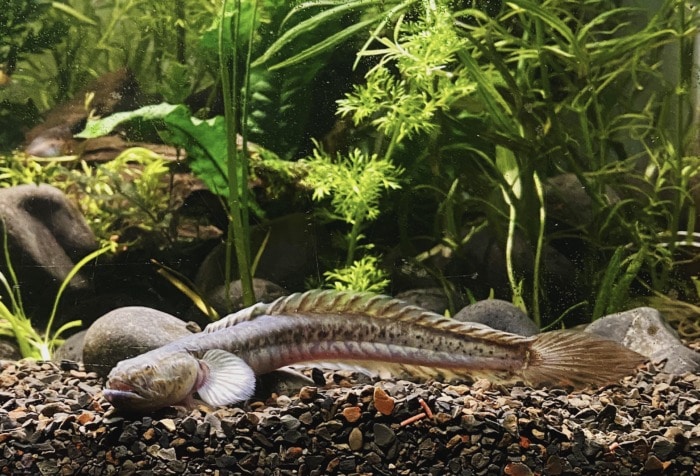
| Preferred Water Salinity: | 1.005 to 1.010 |
| Key Traits: | Extremely peaceful; sifts sand in search of food; prehistoric looks; needs a hideout; not very active |
| Maximum Size: | 24 inches (61 cm) but in home aquaria they usually do not surpass around 15 inches (38 cm) |
| Recommended Tank Size: | 55 gallons |
| Suitable for Beginners: | Yes |
The Dragon Goby, also popular as a Violet Goby, is a relatively docile fish that needs to be kept in brackish water to survive long-term. This goby species grows to about 15 inches of body length in captivity and needs a relatively large tank with dim lighting.
Despite its enormous size, the Dragon Goby won’t try to hunt or kill small fish in its aquarium.
It is actually pretty docile and it enjoys resting in its hideout during most of the day.
When night falls it will become more active and it will scavenge the bottom for food.
Coming from the Gobioides genus, the Dragon Goby is a sand sifting goby which means that it will turn over portions of your sandbed in search of food. Consequently, these brackish fish make for a good cleaner of dirty aquarium substrates.
Author’s note: Dragon gobies are almost blind and not very competitive about food. It would be best if you kept them with no other bottom dwellers that could steal the goby’s food.
7. Golden Wonder Killifish – Aplocheilus lineatus

| Preferred Water Salinity: | 1.000 to 1.005 |
| Key Traits: | Has an enormous appetite; top dweller; good jumper; hardy |
| Maximum Size: | 4 inches (10 cm) |
| Recommended Tank Size: | at least 20 gallons |
| Suitable for Beginners: | Yes |
The Golden Wonder Killifish is a semi-aggressive fish that prefers to stay near the water surface. It is sometimes found living in brackish waters and in an aquarium it can be kept in a low-end brackish environment.
The Golden Wonder Killifish is from the genus Aplocheilus, the name of which is composed of the Greek words “aploe” meaning “simplicity”, and “cheilos” meaning “lip”.
Because the Golden Wonder Killifish is a top-dweller it would feel more confident if your tank has floating plants.
Confidence aside, this fish is a predator known to eat prey that is one-third of its body size of 4 inches.
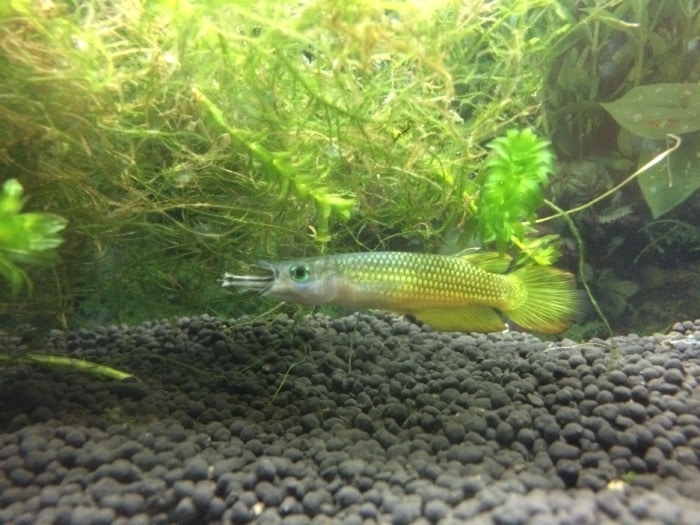
This means that keeping adult Golden Wonder Killifish alongside nano fish is not a good idea.
However, if its tank mates are about the same size or larger, this killifish species will remain peaceful.
8. Bumblebee Goby – Brachygobius xanthozonus
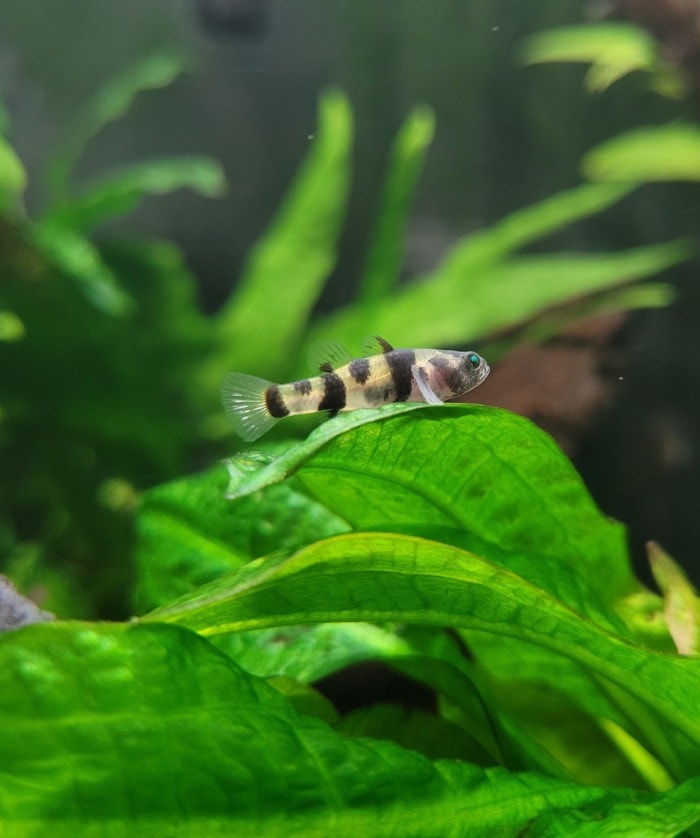
| Preferred Water Salinity: | 1.001 to 1.006 |
| Key Traits: | Doesn’t need a lot of swimming space; peaceful but somewhat territorial; ideal for nano tanks |
| Maximum Size: | 1.3 inches (3.3 cm) |
| Recommended Tank Size: | 10 gallons for a group |
| Suitable for Beginners: | Yes |
The Bumblebee Goby is a brackish nano fish that reaches 1.3 inches in adult size. Because of their small size you can safely keep a group of 7 Bumblebee Gobies in a 10-gallon tank.
The Bumblebee Goby fish are known for their overall calm nature but, when provoked by other nano fish, they will defend their territory.
These colorful gobies from the small Brachygobius genus interact with each other and have a predatory instinct.
If you feed them live foods they will ambitiously dash towards their prey.
However, the Bumblebee Goby is not considered a finicky eater.
Anyway, Bumblebee gobies are good tank mates for the Dwarf Indian Mudskipper.
9. African Mono Sebae – Monodactylus sebae

| Preferred Water Salinity: | 1.005 to 1.025 and even fully marine for adults |
| Key Traits: | needs a large tank to thrive; semi-aggressive; adults can be transitioned to tanks with saltwater |
| Maximum Size: | around 10 inches (25 cm) in length but vertical body height could reach up to 12 inches (30 cm) |
| Recommended Tank Size: | 125 gallons |
| Suitable for Beginners: | No |
The African Mono Sebae is a large aquarium fish, with a unique body shape, that can live in both brackish and marine water. Youngs will do well in low-end brackish aquariums but with time the water salinity should be increased to a specific gravity of no less than 1.015.
The Mono Sebae, a member of the Monodactylus genus, has a semi-aggressive temperament and needs to be kept with equally tempered fish.
Small fish will likely get attacked and eaten if they can fit in the Mono’s mouth.
Anyhow, because of their large size, temperament, and water requirements, the African Mono Sebae fish is not considered beginner-friendly.
To keep these brackish water fish successfully you need to do a good portion of research first.
10. Top Hat Blenny – Omobranchus fasciolatoceps
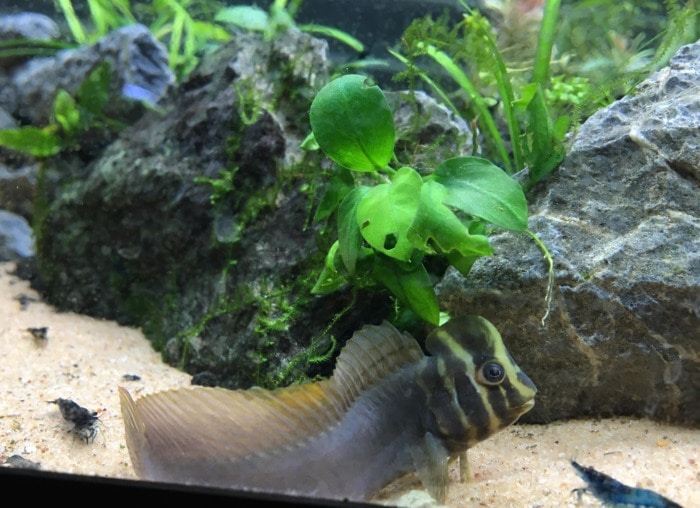
| Preferred Water Salinity: | 1.003 to 1.025 |
| Key Traits: | Likes hiding in its cave; tolerant to a wide range of water salinity; may be territorial; may nip fins; rare |
| Maximum Size: | 3 inches (3.6 cm) |
| Recommended Tank Size: | 10 gallons |
| Suitable for Beginners: | Yes |
The Top Hat Blenny is one of the few blenny species that have been marketed as “freshwater” in the aquarium trade.
In reality, however, this fish is euryhaline and can tolerate a very wide range of water salinity.
The Top Hat Blenny comes from the numerous Omobranchus genus, most of the species of which are discovered in the Pacific, Atlantic, and Indian oceans.
A Top Hat Blenny will likely do best in brackish water with a specific gravity of between 1.003 and 1.015. If they are to be kept in freshwater tanks the water hardness should be in the moderate to high range.
Anyway, this fish species likes to hide most of the time and needs a cave in its aquarium.
Because of its territorial behavior, it may be better to keep just one specimen in a 10-gallon tank.
A male Top Hat Blenny will flare its top fin at intruders and may nip the fins of curious bypassers.
11. Reedfish – Erpetoichthys calabaricus

| Preferred Water Salinity: | 1.000 to 1.003 |
| Key Traits: | They do best in groups; bottom-dweller; needs peaceful tank mates; will eat smaller fish; breathes air; needs a tank with a lid |
| Maximum Size: | 18 inches (45.7 cm) |
| Recommended Tank Size: | 55 gallons for a single adult or a 125-gallon tank for a group of three |
| Suitable for Beginners: | Yes |
Reedfish, also known as Ropefish, are eel-like fish that can live in freshwater and brackish water tanks. They are sociable and have elongated bodies that can grow to 18 inches in length. Because of their adult size, a group of Reedfish may be a good addition to a large brackish aquarium with no other bottom dwellers.
The Reedfish, native to fresh and brackish waters in West and Central Africa, is the only member of the Erpetoichthys genus.
Anyway, what you should know about this fish species is that it’s harmless and it has an excellent pet personality.
To bring out the social behavior of your Reedfish I’d recommend that you keep a group of at least 3.
When kept in groups these eel-like fish like to hang out with each other and explore more often.
Anyway, their tank mates should be calm fish that do not fit in their mouths.
Your tank should have a tight lid because the Reedfish “eel” is very good at escaping through narrow openings.
12. Pacific Blue Eye Rainbowfish – Pseudomugil signifer
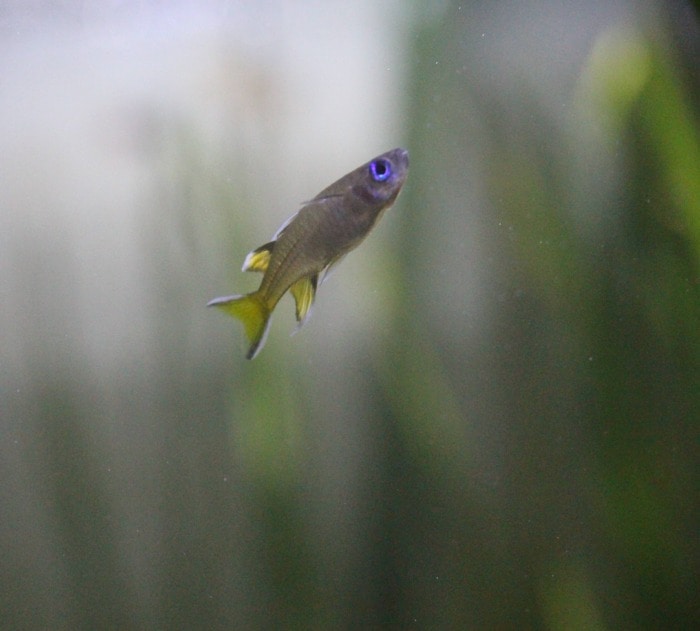
| Preferred Water Salinity: | 1.000 to 1.005 but is euryhaline |
| Key Traits: | Timid around other fish species; top dweller |
| Maximum Size: | around 2.5 inches (6.4 cm) |
| Recommended Tank Size: | standard rectangular aquarium of 15 gallons |
| Suitable for Beginners: | No, these fish are sensitive to swings in water parameters |
The Pacific Blue Eye is a species of rainbowfish that can tolerate a wide range of salinity. Though this fish can live in waters with a salinity of up to 1.025, it will do best in brackish water with a specific gravity of between 1.000 and 1.005.
The Pacific Blue Eye is often marketed as a freshwater species but it is, in fact, euryhaline.
Coming from the Pseudomugil genus distributed in Australia and New Guinea, the Pacific Blue Eye Rainbowfish is found in freshwater rivers, streams, and brackish water.
It’s also worth noting that these fish enjoy living in planted tanks with some driftwood as decor. Microsorum pteropus, also known as Java Fern, is a good example of an easy aquatic plant that thrives in brackish water.
Anyway, since the Pacific Blue Eye does not feel comfortable around other species of fish of its size it may be best to keep them in a species only tank. The males will flare at one another, displaying their beautiful fin patterns.
Once you set up the right tank conditions for these small fish, they will breed without your intervention.
13. Hogchoker – Trinectes maculatus

| Preferred Water Salinity: | 1.005 to 1.010 but is euryhaline and can tolerate up to 1.025 |
| Key Traits: | ambush predator; peaceful; won’t eat dry foods |
| Maximum Size: | up to 6 inches (15.2 cm) when in captivity |
| Recommended Tank Size: | 55 gallons |
| Suitable for Beginners: | Yes |
More often than not you’ll see the Hogchoker marketed as a “Freshwater Flounder” in your local fish store. However, this species is an euryhaline fish and does best in moderately brackish water.
The Hogchoker belongs to the Trinectes genus, whose species are found in both salt and brackish water.
Hogchokers will prefer to stay buried in a substrate of fine sand. There they will patiently wait until night falls to start scavenging.
Fish and shrimp tiny enough to fit in the Hogchoker’s mouth will get ambushed and eaten if given the opportunity.
Author’s note: Since this fish is unlikely to accept dry foods you’d need to provide it with live food at first. To spare you some trial and error I’d recommend giving your Hogchokers live blackworms (if you can find those) or Mysis shrimp.
Anyway, same as the Dragon Goby, a Hogchoker is not very competitive when feeding.
Therefore, it’s best to avoid other aggressive feeders that dwell at the bottom.
Also, it’s not a good idea to keep Hogchokers around aggressive fish known to nip at fins.
Brackish puffer fish are out of the question.
14. Fat Sleeper Goby – Dormitator Maculatus

| Preferred Water Salinity: | 1.010 to 1.025 |
| Key Traits: | Territorial; opportunistic feeder that will try to eat fish almost half its size; should be housed with large but not very aggressive fish |
| Maximum Size: | 12 inches (30.5 cm) is the common adult size in captivity |
| Recommended Tank Size: | upwards of 100 gallons |
| Suitable for Beginners: | No |
The Fat Sleeper Goby, a member of the genus named Dormitator, is also known as Jade Goby in the aquarium trade.
They can be caught in the brackish coastlines of all of Florida.
Anyhow, the Fat Sleeper Goby fish grow to a relatively large size of 12 inches on average and are territorial.
However, they won’t go out of their way to bother equally-sized fish and don’t do well around fin nippers.
For these reasons, the Fat Sleeper Gobies are best kept in large brackish tanks with fish of equal size and demeanor.
Anyway, a cool trait of this fish is that it’s not a picky eater.
In fact, every time it eats it will be like it is its last meal.
15. Banded Banjo Catfish – Platystacus cotylephorus
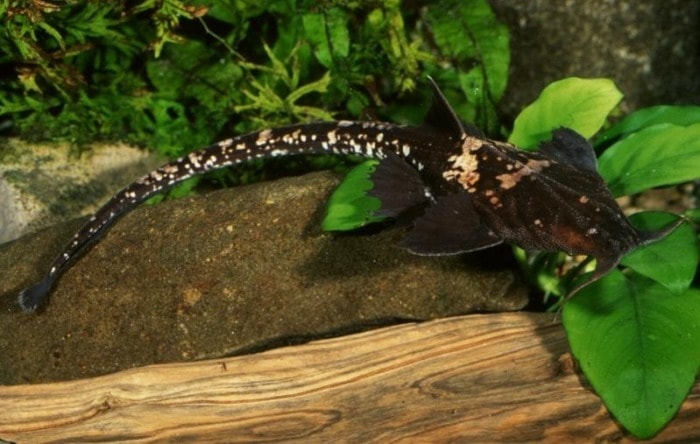
| Preferred Water Salinity: | 1.003 to 1.010, but can tolerate up to 1.025 |
| Key Traits: | nocturnal; predatory; peaceful; should be fed after lights out |
| Maximum Size: | around 12.5 inches (31.8 cm) |
| Recommended Tank Size: | 55 gallons or any other tank with at least 48 inches of length and 12 inches of width |
| Suitable for Beginners: | No |
The Banded Banjo Catfish is a secretive, docile fish that thrives in brackish water with a salinity of about 1.005. This catfish species prefers to stay hidden most of the time and nocturnal by nature.
The Banded Banjo Catfish, the only member of its genus – Platystacus, grows to about 13 inches in length and should not be housed with fish that fit in its mouth.
Its tank mates should be peaceful fish that are large enough not to get eaten.
Anyway, these catfish can be kept with others of their kind as long as there are enough hiding places in your tank.
Territorial disputes among Banded Banjo Catfish are very rare.
16. Indonesian Tiger Fish – Datnioides microlepis
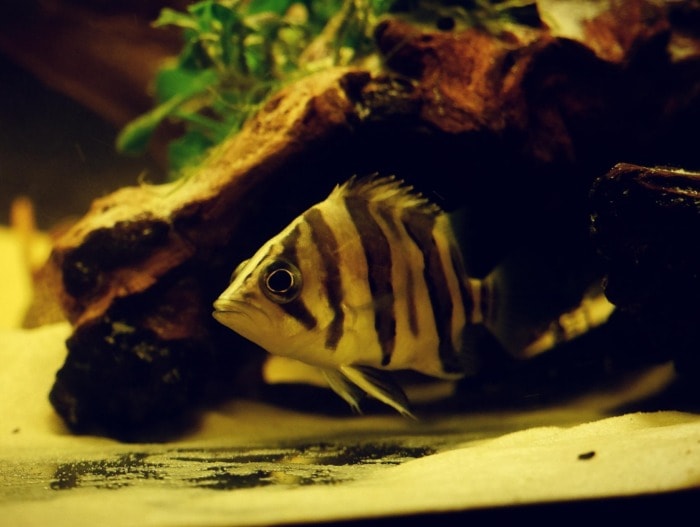
| Preferred Water Salinity: | 1.000 to 1.005 |
| Key Traits: | predatory; prefers planted tanks; peaceful with other large fish |
| Maximum Size: | around 14 inches (35.6 cm) in captivity but 18 inches (45.7 cm) is not unseen |
| Recommended Tank Size: | 125 gallons but 180 is better |
| Suitable for Beginners: | No |
The Indonesian Tiger Fish is a predatory species that grows to about 14 inches. These colorful fish should be kept in very large brackish aquariums or ponds with a salinity of around 1.003.
The Indonesian Tiger Fish is a species within the Datnioides genus which inhabits fresh and brackish waters in South and Southeast Asia and New Guinea.
Though the Indonesian Tiger Fish grow big as adults, it’s generally agreed that they are a slow grower.
However, these fish will try to eat any other tank mate that’s less than half their size.
Incredibly, they will be very peaceful to other large fish.
Ultimately, you should avoid housing Indonesian Tiger Fish with super aggressive tank mates.
17. Guppy Fish – Poecilia reticulata

| Preferred Water Salinity: | between 1.003 and 1.010 |
| Key Traits: | needs very hard water; hardy; livebearer; may breed excessively |
| Maximum Size: | varies with types but usually no more than 1.4 inches (3.6 cm) |
| Recommended Tank Size: | 5 gallons but larger tanks are better for groups and management of fry |
| Suitable for Beginners: | Yes |
Contrary to popular belief, the Guppy fish may stay healthier and live longer in brackish water rather than in freshwater. They can even tolerate marine levels of salinity, but in general do very well in hard water with a specific gravity of between 1.003 and 1.010.
The Guppy Fish belongs to the well-known Poecilia genus which contains about 40 recognized species.
Guppies remain rather tiny but they tend to breed almost constantly.
This means that managing their ever-growing population would be easier in larger tanks.
A group of Guppy fish would populate a 5-gallon tank fairly quickly. However, if you’re mindful about exporting the fry, Guppies become one of the best fish to stock a small tank.
If you’re new to the whole Guppy thing, then I’d recommend getting a 15-gallon tank as a beginner.
Anyway, Guppies are exceptionally hardy and are a species of fish that thrive even in a low-maintenance aquarium. Other than that, having self-sustaining live plants in the tank helps these brackish fish to feel better and more confident.
18. True Black Molly – Poecilia sphenops

| Preferred Water Salinity: | between 1.001 to 1.019 |
| Key Traits: | Peaceful; hardy; algae-eater |
| Maximum Size: | 5 inches (12.7 cm) |
| Recommended Tank Size: | 20-gallon tank or larger |
| Suitable for Beginners: | Yes |
The True Black Molly (Poecilia sphenops) is a jack of all trades. It can live in freshwater, brackish and even saltwater environments with proper transitioning. However, for optimal health they should be kept in water with a salinity between 1.001 and 1.020.
Apart from their resilience, these dark skinned fish have an insatiable appetite for algae.
And not just any type of algae.
While they’ll mostly eat hair algae, true black mollies will also snack on the bane of all fishkeepers – black beard algae.
Due to this, they’re often included in the clean-up crew in tropical aquariums.
Since they’re hardy and great at dealing with algae, true black mollies are also one of the best fish for beginners.
Inexperienced fishkeepers should keep two things in mind when caring for these fish.
First, as with pretty much most types of aquarium species, males will become aggressive towards each other if there aren’t enough females to go by.
So to mitigate their violent tendencies, you’ll need to have 2 females for every male in your tank.
Otherwise, they’ll enter a fin measuring contest that won’t end pretty.
The second thing that beginners will need to remember is to provide true black mollies with enough cover.
This can be done by including fast-growing, surface-level plants such as hornwort.
What’s the secret to keeping brackish fish successfully?
To set up a successful brackish tank you’d need to know how to make brackish water by achieving the right salinity.
For example, you should be using marine salt and not aquarium salt.
You would also use a particular formula to calculate the water’s specific gravity and then measure it to see if you got it right. Speaking of which, the most accurate way to measure salinity is with a refractometer.
Since most of the species listed above are tolerant to different ranges of salinity, I prefer to have an accurate refractometer at hand.
However, I don’t like getting too punctual about achieving the perfect specific gravity.
I just take into account the fish I will be keeping in my aquarium and adjust the salinity of my brackish water to a reasonable range for them.
So did you like my list?
Share your opinion in the comment section below.





